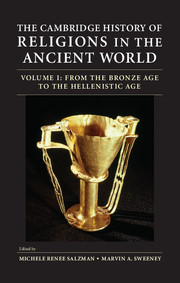Book contents
- Frontmatter
- Contents
- List of Figures and Maps
- List of Contributors
- List of Abbreviations
- Acknowledgments
- Introduction to Volumes I and II
- Introduction to Volume I
- Part I Mesopotamia and the Near East
- Part II Egypt and North Africa
- Part III Greece and the Eastern Mediterranean
- Part IV The Western Mediterranean and Europe
- Suggestions for Further Reading
- General Index
- Index of Citations
- Frontmatter
- Contents
- List of Figures and Maps
- List of Contributors
- List of Abbreviations
- Introduction to Volume II
- Part I Iran and the Near East
- 1 Religion in Iran
- 2 Creating Local Religious Identities in the Roman Near East
- 3 Judaism in Palestine in the Hellenistic-Roman Periods
- 4 Post-70 Judaism in Judea and the Near East
- 5 Christianity in Syria
- Part II Egypt and North Africa
- Part III Greece and Asia Minor
- Part IV Italy, Roman Gaul, and Spain
- Suggestions for Further Reading
- General Index
- Index of Citations
5 - Christianity in Syria
from Part I - Iran and the Near East
Published online by Cambridge University Press: 05 October 2013
- Frontmatter
- Contents
- List of Figures and Maps
- List of Contributors
- List of Abbreviations
- Acknowledgments
- Introduction to Volumes I and II
- Introduction to Volume I
- Part I Mesopotamia and the Near East
- Part II Egypt and North Africa
- Part III Greece and the Eastern Mediterranean
- Part IV The Western Mediterranean and Europe
- Suggestions for Further Reading
- General Index
- Index of Citations
- Frontmatter
- Contents
- List of Figures and Maps
- List of Contributors
- List of Abbreviations
- Introduction to Volume II
- Part I Iran and the Near East
- 1 Religion in Iran
- 2 Creating Local Religious Identities in the Roman Near East
- 3 Judaism in Palestine in the Hellenistic-Roman Periods
- 4 Post-70 Judaism in Judea and the Near East
- 5 Christianity in Syria
- Part II Egypt and North Africa
- Part III Greece and Asia Minor
- Part IV Italy, Roman Gaul, and Spain
- Suggestions for Further Reading
- General Index
- Index of Citations
Summary
The history of Christianity in Syria is a story of how this burgeoning religious movement of Late Antiquity came to take on a distinctively regional dress. Effectively a large frontier zone between the Roman and the Parthian (and later the Persian) empires, Syria was exposed to ever-changing cultural and political influences. While Aramaic, with many regional variations, was the dominant language in this milieu, from the late fourth century BCE onward Greek language and culture also gained a powerful presence. From the last third of the second century BCE, local circumstances allowed the development of the semi-independent kingdom of Edessa. Here the cultivation of the native Aramaic dialect eventuated in the appearance of Syriac, an Aramaic idiom that facilitated the growth of a unique Christian identity in cultural terms, defined largely in reaction to and/or in tandem with Greek thought and religious expression. While inscriptions and other archaeological evidence document the beginnings, for the most part the historical evidence is literary.
Edessene Christianity
To the north and east of the Roman province of Syria, beyond the Euphrates and just within the borders of the province of Mesopotamia (Persian Osrhoene), lay the city of Edessa. Founded in 304 BCE by the Greek-speaking Seleucus I Nicator, the name Edessa recalled the city of the same name in Seleucus’s native Macedonia. Syriac-speaking locals, however, have persistently called the city Ûrhāy. In Parthian times, from around the year 132 BCE onward, the city and its associated territories became the kingdom of Edessa, a dignity it preserved until the year 214 CE, when it officially became a Roman colony. In the environs of Edessa, sometime in the early first century CE, developments in the writing of Aramaic began to take the form that in due course would come to be called Syriac. From about the middle of the second century CE until well into Islamic times, Syriac, the standard Aramaic of a large corpus of mostly Christian texts, was, together with Greek, one of the principal vehicles of Christianity in Syria and eastward. Indeed, by the fifth century Syriac and its associated ecclesiastical culture had extended its influence well to the west of the Euphrates.
- Type
- Chapter
- Information
- The Cambridge History of Religions in the Ancient World , pp. 138 - 162Publisher: Cambridge University PressPrint publication year: 2013



